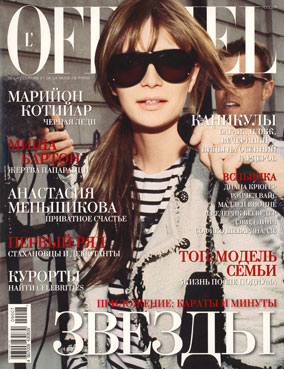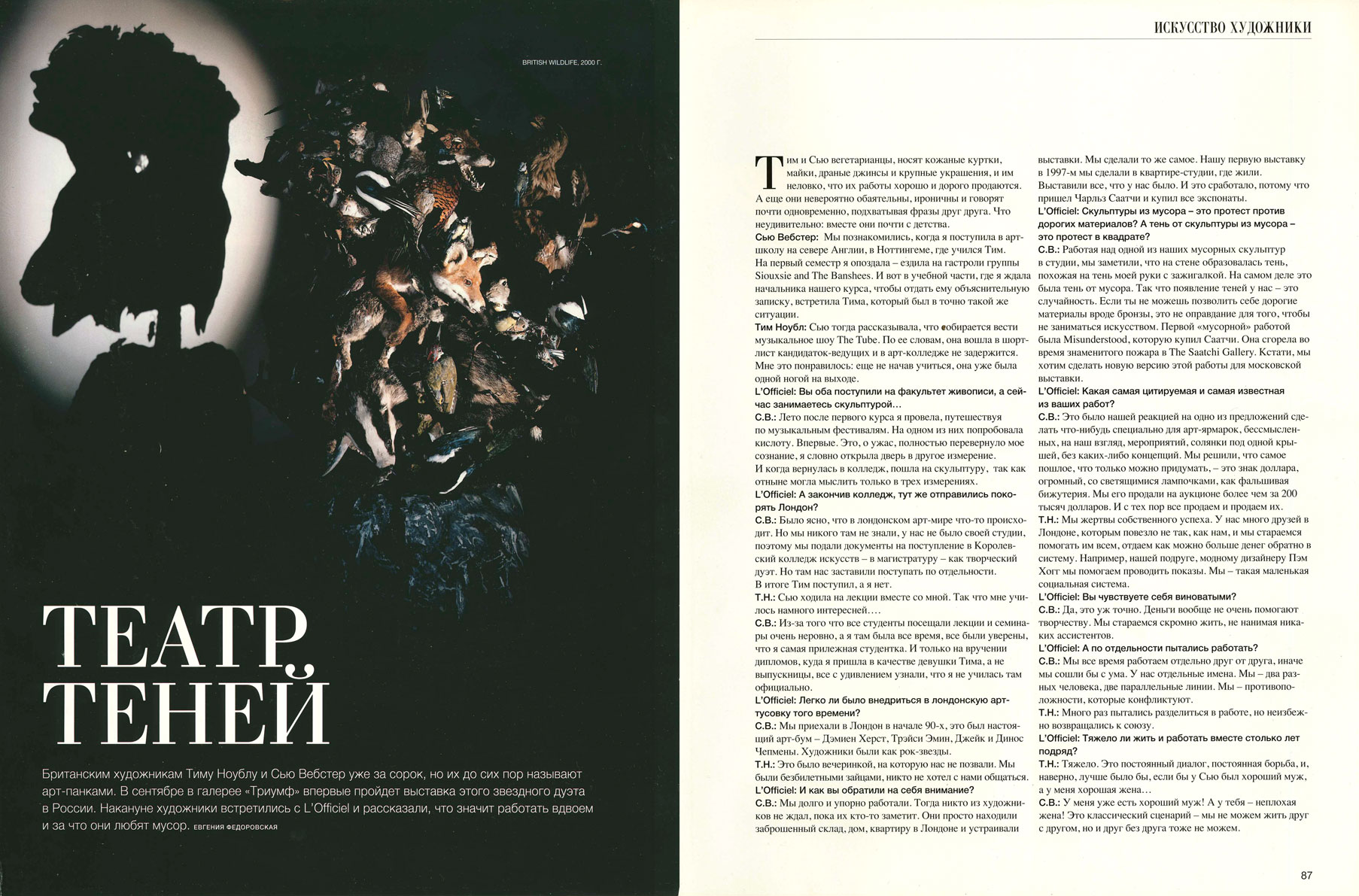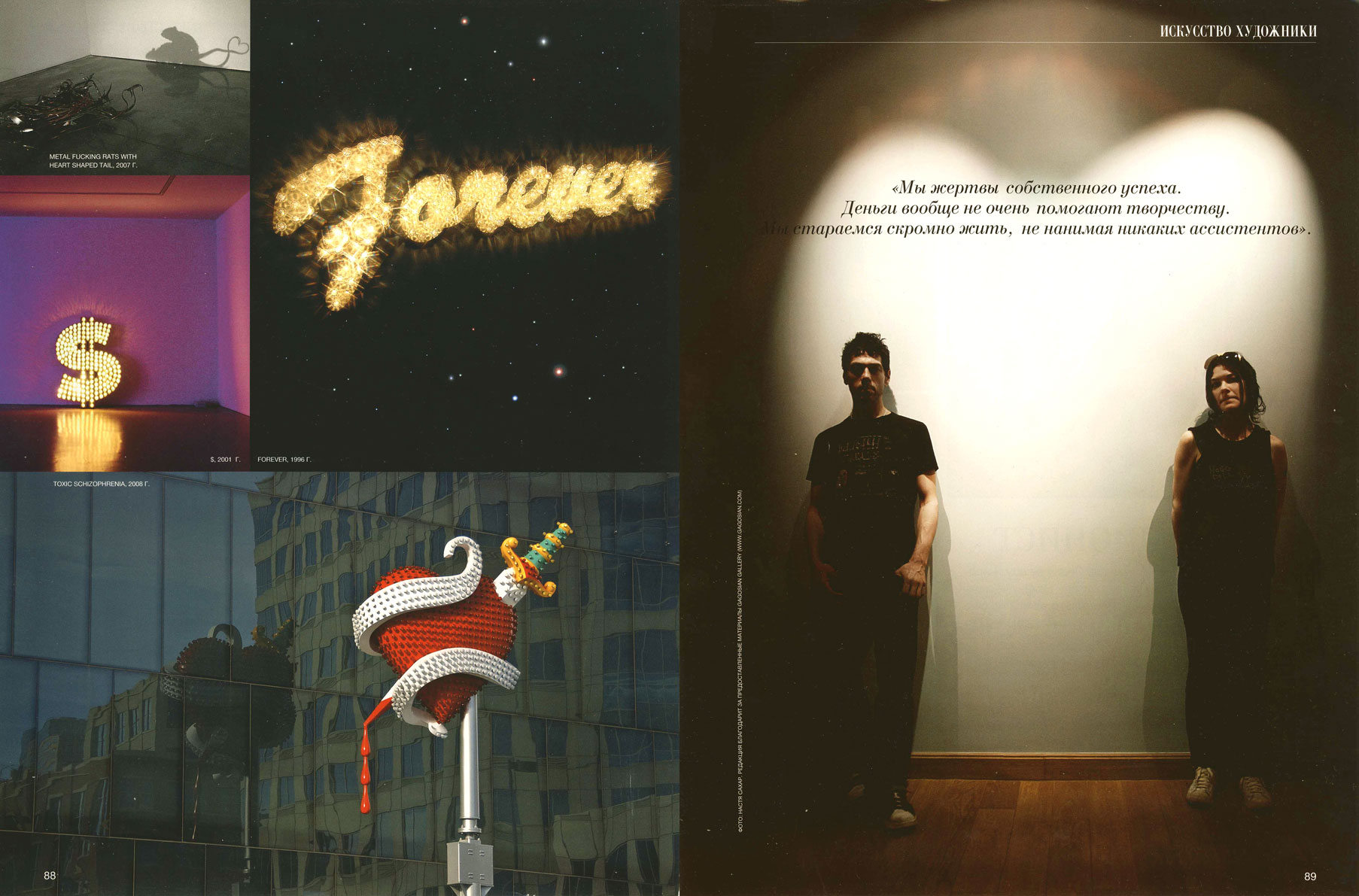


British artists Tim Noble and Sue Webster are already over 40 but they're still known as art punks. In September Triumph Gallery will show the first exhibition in Russia of this pair of art stars. Recently the artists told L'Officiel what it means to work together and why they love rubbish. Evgenia Fedorovskaya.
Tim and Sue are vegetarians who wear leather jackets, t-shirts, ripped jeans and chunky jewellery and they're rather uncomfortable with the fact that their work sells well and for high prices. They're also incredibly charming, with a dry sense of humour and they talk almost simultaneously, finishing each other's sentences. That's not surprising as they've been together almost since childhood.
SW: We met when I went to art school in the north of England, in Nottingham, where Tim was studying. I missed the beginning of the first term as I was on tour with Siouxsie and the Banshees. While I was in an office waiting for the course tutor in order to give him an absence note I met Tim, who was in the same situation as me.
TN: Sue told me she was planning to be a presenter on the music show The Tube. According to her she had been short-listed and wouldn't stay at art school. I liked that, especially as she hadn't even set foot in college at that stage.
L'Officiel: You both studied painting and now you make sculpture . . .
SW: I spent the summer at the end of first year travelling around music festivals. At one of them I tried acid for the first time. It was a nightmare. It completely turned my world around and opened the door to another dimension. When I got back to college I turned to sculpture, as from then I could only think in three dimensions.
L'Officiel: And once you'd finished college did you set out to conquer London?
SW: It was obvious something was happening in the London art world but we didn't know anyone there and we didn't have a studio so we applied as a creative duo for a masters at the Royal College of Art. They made us apply separately. Tim got in and I didn't.
TN: Sue came to lectures with me. That made it much more interesting for me . . .
SW: I was there the whole time and, as most students attended lectures and seminars very rarely, everyone was sure I was the hardest-working student. It was only when I attended the graduation ceremony as Tim's girlfriend, and not as a graduating student, that everyone realised, to their amazement, that I hadn't actually been an official student.
L'Officiel: Was it easy to fit in to the London art scene in those days?
SW: We moved to London at the beginning of the 1990s when there was a real art boom — Damien Hirst, Tracey Emin, Jake and Dinos Chapman. Artists were like rock stars.
TN: It was a party to which we weren't invited. We were poor little lambs without tickets and no one wanted to have anything to do with us.
L'Officiel: And how did you draw attention to yourselves?
SW: We worked persistently. At that time artists didn't wait until someone noticed them. They simply found an abandoned warehouse, house or flat in London and organised exhibitions. We did exactly that. Our first exhibition, in 1997, was in the studio flat where we lived. We showed all of our works. And it paid off, as Charles Saatchi came along and bought everything.
L'Officiel: Are your rubbish sculptures a protest against expensive materials? And is the shadow from those sculptures a protest at the square?
SW: When we were working on a rubbish sculpture in the studio we noticed that there was a shadow on the wall which looked like my hand holding a lighter. In fact it was a shadow from the rubbish. So our shadow works started accidentally. Even if you can't afford expensive materials such as bronze, it's no reason not to make art. Our first 'rubbish' work was Miss Understood & Mr Meanor, which was bought by Saatchi. It was destroyed in the famous fire at the Saatchi Gallery (sic). Incidentally, we would like to make a new version of that work for the Moscow show.
L'Officiel: What's the most quoted and best-known of your works?
SW: It's one we made when asked to create something for an art fair. In our view art fairs are pointless events, with a mish-mash of works under one roof and no concept at all. The most vulgar thing we could think of was a huge dollar sign with flashing lights, like costume jewellery. We sold the work at auction for more than $200,000. And up until now we keep selling them.
TN: We're victims of our own success. We've got lots of friends in London who haven't had the same amount of success as us and we try to help them and put as much money as possible back in to the system. For example we help our friend, fashion designer Pam Hogg, to organise catwalk shows. We're like a little social security system.
L'Officiel: Do you feel guilty?
SW: Yes, definitely. Money doesn't help creativity. We try to live modestly and we don't have any assistants.
L'Officiel: Have you tried to work individually?
SW: We always work separately from each other, otherwise we'd go mad. We have different names. We're two different people, two parallel lines. We're opposites which repel.
TN: We've tried many times to work as individuals but we always come back together.
L'Officiel: Is it difficult to live and work together for so many years?
TN: It's difficult. There's constant dialogue and constant struggle and it would probably be better if Sue had a good husband and I had a good wife . . .
SW: I already have a good husband! And you have a pretty good wife! It's a classic scenario. We can't live with each other and can't live without each other.
(Quote above portrait: We're victims of our own success. Money doesn't help creativity. We try to live modestly and don't have any assistants).
